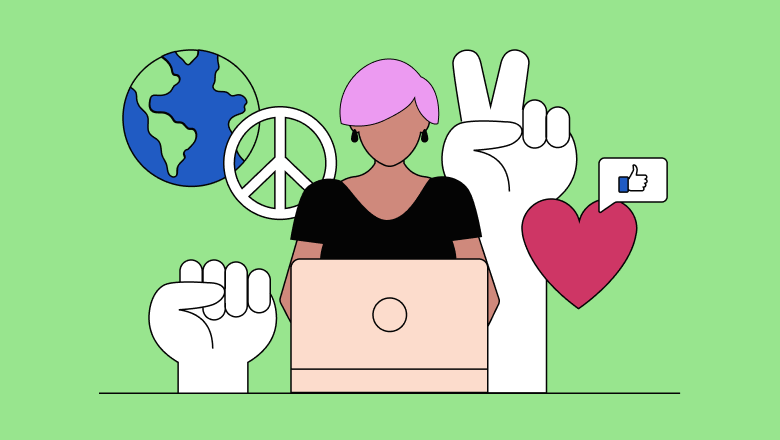Is influencer activism the new brand activism?

Table of Contents
We recently asked 2,000 consumers if they expect influencers to take a stand on social issues. Almost all (87%) strongly or somewhat agreed. This number rises to 90% for Millennials and Gen Z.

When you compare consumers’ expectations of influencers with their expectations of brands, there’s a dramatic difference. According to The 2023 Sprout Social Index™, only 25% of consumers said the most memorable brands speak about causes and news that align with their values. But that doesn’t mean this issue is irrelevant to marketers.
As the calls for influencer-led social media activism grow louder, brands need to be prepared to deal with the consequences. In this guide, we explain what influencer activism is, how it affects brand partnerships and how it will alter the future of influencer marketing.
What is influencer activism?
Influencer activism describes influencers and creators using social media as a tool to campaign and advocate for political, social or environmental causes. Influencer activism can include collaborations with nonprofits, and usually serves to raise awareness and mobilize action. Influencers may ask their followers to sign a petition, make a donation, participate in a protest or make lifestyle changes.
For example, @GreenGirlLeah uses her platform to educate her audience about intersectional environmentalism, and segued her community-building efforts into a nonprofit organization that provides resources for the cause.
While influencer activism can be very effective, it has also come under fire for being perceived as performative. “Slacktivism,” as performative activism is sometimes called, prioritizes appearances and personal branding over genuine commitment. Superficial engagement without long-term follow-through—like only posting hashtags or posting about an issue just because it’s trending—dilutes the efforts of true activists and shifts focus away from more impactful messages.
Often, influencer activism goes astray when influencers support causes with self-promotion in mind, or, more innocuously, succumb to social pressure to speak out (even if they’re ill- or under-informed).
The next evolution of brand activism
Where did the demand for influencer activism come from? And why do so many consumers expect influencers to have a public point of view on timely issues?
A few years ago, brands taking a stand was the norm. Sprout’s 2019 #BrandsGetReal Report found that 70% of consumers then believed it was important for brands to have a public stance on social and political issues, a stark difference from where we are today. The report declared it was “the era of the conscious consumer,” but warned brands consumers were already growing weary of “woke-washing” and performative activism.
By 2020, in the wake of the COVID-19 pandemic, the Black Lives Matter movement and a contentious US presidential election, brand activism emerged as a non-negotiable business strategy and exploded in the cultural zeitgeist. Brand activism—the act of a business actively advocating for or against certain issues—goes beyond traditional corporate responsibility and beckons tangible cultural change. But the surge of brands putting forth “activist” content largely backfired—many were accused of getting it wrong, overwhelming their audiences or performing to bolster the bottom line.
That’s where influencers come in. While interest in brand activism hasn’t completely waned, most consumers seem to believe the social media activism baton should be passed to influencers. Through parasocial relationships and growing cultural relevance, influencers have become role models and moral guideposts in the eyes of many. Even if they don’t want to be.
Across platforms, influencers are being spammed with calls to speak out about nearly every current event. Including topics that they are (admittedly) not qualified to speak on. Audiences threaten to cancel or abandon them (and brands they work with) if they don’t—or if they disagree with their stance.
How influencer activism impacts brand partnerships
According to the Q2 2024 Sprout Pulse Survey, 42% of consumers will unfollow brands if they work with influencers that don’t align with the consumer’s values. Considering 68% of consumers follow brands to stay up to date on new products and services, losing followers can have serious implications on revenue.

With stakes that high, brands need to be extremely careful when selecting influencers so they can meet their audience’s expectations and protect their reputation.
Identifying influencers
In the age of influencer activism, brands need to do more thorough vetting and background research to understand what causes influencers have spoken up about in the past. Finding the right influencers takes more than looking at follower count or engagement rate. It requires digging into what they’ve posted, accounts they’ve interacted with and audience reactions.
That might lead some marketers to believe it’s best to find influencers who are completely cause-agnostic. But, in reality, finding influencers whose advocacy aligns with your brand values endears you to your community and enhances your brand. As Greg Rokisky, Senior Social Media Strategist at Sprout Social puts it, “When partnering with influencers and creators, the Sprout team examines potential partners’ overall content and presence to ensure they align with our core values. That doesn’t mean uniformity in thought or that we shy away from bold opinions…At the end of the day, these partnerships are meant to create meaningful connections and add value to our community.”
You can see examples of brands doing this well in anticipation of the 2024 US presidential election. Like when Reformation partnered with Monica Lewinsky on their new line of workwear. The partnership seemed authentic and true to the ethos of the brand—which is why it went viral and was received so well on social.
Understanding audience expectations
The ultimate barometer of what your brand should be speaking out about is audience sentiment. It’s more important than ever to know what causes customers and prospects want your brand—and the influencers you work with—to lend your platform to.
Done right, partnering with influencers can demonstrate your brand’s year-round commitment to issues that matter most to your audience. By building long-term relationships with influencers who resonate with your target market, you can deliver sustainable brand advocacy that actually makes a difference, and protect your brand health.
Take Topicals. The skincare brand aims to take the shame out of skin conditions—instead making skincare fun, approachable and accessible. Founded by two BIPOC women who were consistently disappointed when doctors told them they didn’t know how to treat inflammation and eczema in people with darker skin, the brand features influencers with a diverse range of skin tones in their campaigns.
The influencers Topicals partner with, including their 2024 Topicals Hype Members, all celebrate the beauty of real skin and use their platform to speak out against unrealistic standards. They epitomize the brand’s values, and speak directly to the feelings of Topicals’ audience.
Outlining brand safety measures
Even with comprehensive vetting processes and a clear view of your audiences’ top social, political and environmental concerns, there may be additional brand safety protocols you need to follow when working with influencers in today’s climate. For example, are there certain issues that your brand (or your legal team) does not want to align with in any way? Even via influencer partnerships?
If you’re unsure, the best way to find out is by meeting with your legal team and senior leadership. Get clarification on what topics are off the table. From there, build clear brand safety guidelines that outline what’s appropriate and what’s not. For example, you could ask, “Will our brand be endorsing a candidate in this year’s presidential election? Will we be partnering with influencers who do?” It’s better to seek this information out proactively than wait until a crisis is already unfolding.
Influencer activists are friend, not foe
It’s too soon to tell if influencer activism is here to stay, or if it will dissipate in the next few years—going the way of brand activism. But what is certain is that there is currently an intense consumer demand for influencer-led activism, and it can have serious implications on your brand’s perception.
By partnering with influencers who align with your company’s values, you can strengthen your credibility, foster community and forge deeper audience connections. Carefully selecting the right influencers mitigates the risks of audience backlash, and leads to long-term loyalty and advocacy. Embracing influencer activism thoughtfully is essential for maintaining relevancy and sustainable success.
Looking for more on consumers’ evolving expectations toward influencers? Read The 2024 Influencer Marketing Report.








Share